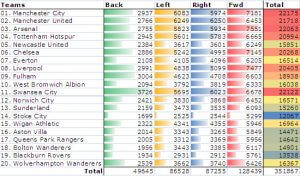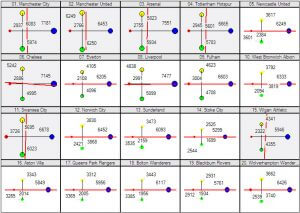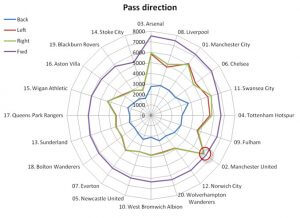In this latest post, I show how data that looks rather uninteresting and uninspiring in tabular form can reveal some interesting insights when visualised with appropriate graphics.
This is my second analysis of the 2011/12 EPL Opta dataset provided by the MCFC project. In my previous one, I looked at Pass direction in order to refute the Fink Tank analysis on Long balls. In the process, I produced some graphs which actually give further support to my conclusion, and are a clear demonstration of the power of visual analysis.
Let’s start with the data…

Looking at this table is not easy to spot major differences in Pass direction between the clubs. But if we plot this data (see graph below), and we fit an orthogonal straight line (red line) to it, we can now easily notice that this line is (or almost) vertical for some clubs, and (almost) horizontal for others.
The line position indicates that there is a major (significant) difference between the two sets of clubs. Those with a vertical line show a predilection for sideways passing (left/right), while the others for forward passing (back/forward). The graph does not give a clear-cut answer for all clubs (four points are too few to produce a well-defined line in such a small graph), and we can see that Chelsea is borderline. In fact, a discriminant analysis of this data shows that Chelsea, Liverpool, Everton, and Fulham also belong to the sideways set. More importantly, what the graph show clearly is that the top four clubs (with Swansea and Wigan) all tend to pass the ball sideways, rather than forward.

To emphasise the power of visualisations to highlight irregularities in the data, below is a radar (polar cap?) chart of the same data. The clubs are in order of Forward passes. Some interesting information can be gathered just by looking at it, for example:
1. Stoke makes the lowest number of passes.
2. All clubs make an almost equal number of left/right passes.
2. Manchester United is unique in making an almost equal number of left/right/forward passes.


Hi, I find your passing direction graphs to be very interesting. What is the logic behind the orthogonal red line? How do you calculate its slant? Good work by the way.
Thanks! The orthoganal red line is calculated automatically by the graphic software I use given the four direction totals for each team. Think of it as being slanted to the directions with the highest totals.